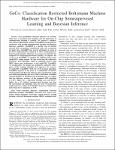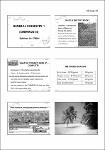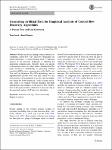- BB
Authors: Atwan, Zeenah Weheed; Advisor: -; Participants: - (2020) - Adenovirus hexon in interferon-deficient cells showed different expression levels when data were normalized to GAPDH or 18S. Consistently, hexon expression levels were different in untreated cells under the control or heat-shocked conditions when data were normalized to GAPDH or 18S. Promyelocytic leukemia protein II (PML-II) expression level was lower in HeLa-PML-II-deficient cells (PML-II-Kd) compared to the control when the data were normalized to GAPDH as a reference gene and also in GAPDH RNA spiked, which showed reasonable consistency. More consistent data were obtained when the GAPDH normalizer was added before the step of treating the extracted RNA with DNase compared to add i...
|
- BB
Authors: Enerijiofi, Kingsley Erhons; Advisor: -; Participants: Akapo, Funmilayo Hannah; Erhabor, Joseph Omorogiuwa (2021) - Aqueous and ethanol extractions from Moringa oleifera yielded 40.75% and 62.87%, respectively. Flavonoid (20.76 mg/100 g) was the highest, while saponin (2.00 mg/100 g) was the least of all phytochemicals detected. The proximate nutrient composition revealed that carbohydrate (46.59%) had the highest, while lipid (7.37%) was the least. Eleven compounds were detected in both extracts by gas chromatography–mass spectrometry. The eleven compounds identified had higher concentrations in the ethanol extract except 2-octenoic (26.09 mg/kg) acid and 1, 2-epoxyhexadecane (8.84 mg/kg) in aqueous extract which were considerably higher than 0.62 mg/kg and < 0.01 mg/kg in ethanol extract. The min...
|
- BB
Authors: Mohammed, Abdelhafeez M. A.; Advisor: -; Participants: Alrayeh, Alrayeh S.; Mohamed, Moawia E.; Abdel-Rahman, Nawal A. (2021) - The graphite furnace–atomic absorption spectrometry determined the presence of sodium (6.38 ppm), potassium (701.93 ppm), calcium (371.28 ppm), magnesium (54.78 ppm), cadmium (0.013 ppm), zinc (0.256 ppm) and lead (0.200 ppm). The content of peel, moisture and ash of C. macrophylla was measured as 18.35%, 23.75% and 2.04%, respectively. Among thirty compounds identified using gas chromatography–mass spectrometry, limonene is the major compound (72.85%). The vitamin C (ascorbic acid) content of C. macrophylla juice was determined as 55.0 mg/100 g. The fruit diameter, fruit weight and percentages of juice, peel and seed were determined as 91.4 mm, 276.5 g, 47.92%, 26.37% and 19.20%, res...
|
- BB
Authors: Yi, W.; Advisor: -; Participants: Park, J.; Kim, J. (2019) - The probabilistic Bayesian inference of real-time input data is becoming more popular, and the importance of
semisupervised learning is growing. We present a classification restricted Boltzmann machine (ClassRBM)-based hardware accelerator with on-chip semisupervised learning and Bayesian inference capability. ClassRBM is a specific type of Markov network that can perform classification tasks and reconstruct its input data. ClassRBM has several advantages in terms of hardware implementation compared to other backpropagationbased
neural networks. However, its accuracy is relatively low compared to backpropagation-based learning. To improve the accuracy of ClassRBM, we propose the multi-...
|
- BB
Authors: Ganapati, Ratan Kumar; Advisor: -; Participants: Rasul, Md Golam; Sarker, Umakanta; Singha, Ashutus; Faruquee, Muhiuddin (2020) - In this study, generation mean analysis has been performed for yield-contributing traits and found that plant height, no. of primary branches panicle−1, no. of secondary branches panicle−1, no. of filled grain panicle−1, no. of grain panicle−1 and dominant effects for yield hill−1, yield tiller−1, and 1000 grain weight have association to yield, governed by additive gene effect. In respect of epistatic effect, duplicate epistasis was predominant for all the traits except panicle length. From a heritability view, plant height, no. of primary branches panicle−1, and no. of grain panicle−1 showed high heritability and plant height, panicle length, no. of filled grain panicle−1, and 1000 ...
|
- LT
Authors: Lê, Minh Thành; Advisor: -; Participants: - (2016) - -
|
- BB
Authors: Jouck, Toon; Advisor: -; Participants: Depaire, Benoı ˆ t (2019) - Within the process mining domain, research on comparing control-flow (CF) discovery techniques has
gained importance. A crucial building block of empirical analysis of CF discovery techniques is obtaining the
appropriate evaluation data. Currently, there is no answer to the question of how to collect such evaluation data. The paper introduces a methodology for generating artificial event data (GED) and an implementation called the Process Tree and Log Generator. The GED methodology and its implementation provide users with full control over the characteristics of the generated event data and an integration within the ProM framework. Unlike existing approaches, there is no tradeoff bet...
|
- BB
Authors: Elberink, Sander Oude; Advisor: -; Participants: - (2014) - This paper describes the generation of a national three-dimensional (3D) dataset representing the virtual and landscape model. The 3D model is produced automatically by fusing a two-dimensional (2D) national object-oriented database describing the physical landscape and the national high-resolution height model of the Netherlands. Semantic constraints are introduced to correctly model 3D objects. Three areas from different regions in the Netherlands have been processed in order to develop, improve and test the automatic generation of a national 3D city and landscape model. Specific attention has been paid to exceptional cases that may occur in a nationwide dataset. Based on the test r...
|
- BB
Authors: Khoshelham, K.; Advisor: -; Participants: - (2013) - Registration of RGB-D data using visual features is often influenced by errors in the transformation of visual features to 3D space as well as the random error of individual 3D points. In a long sequence, these errors accumulate and lead to inaccurate and deformed point clouds, particularly in situations where loop closing is not feasible. We present an epipolar search method for accurate transformation of the keypoints from 2D to 3D space, and define weights for the 3D points based on the theoretical random error of depth measurements. Our results show that the epipolar search method results in more accurate 3D correspondences. We also demonstrate that weighting the 3D points improve...
|
- BB
Authors: Wani, M.A.; Advisor: -; Participants: Ganaie, A.A. (2019) - From TrxG, ISWI and Acf were selected, and from PcG, Pc and Psc were selected. Three pAc-sgRNA-Cas9-puro-vector constructs for ISWI gene, one pAc-sgRNA-cas9-puro-vector construct for Pc, gene and two pAc-sgRNA-cas9-puro-vector constructs for each of the Acf and Psc gene were generated. These constructs were confirmed by PCR and sequencing. In the future, these constructs will be used to study the role of their respective target genes in chromatin organization.
|
- BB
Authors: Graaff, Victor de; Advisor: -; Participants: - (2015) - Recommender systems have been around for decades to help people find the best matching item in a pre-defined item set. Knowledge-based recommender systems are used to match users based on information that links the two, but they often focus on a single, specific application, such as movies to watch or music to listen to. In this paper, we present our Interest-Based Recommender System (IBRS). This knowledge-based recommender system provides recommendations that are generic in three dimensions: IBRS is (1) domain-independent, (2) language-independent, and (3) independent of the used social medium. To match user interests with items, the first are derived from the user’s social media pro...
|
- BB
Authors: El-Mouhamady, Almoataz Bellah Ali; Advisor: -; Participants: Gad, Abdul Aziz M.; Karim, Ghada S. A. Abdel (2020) - The final results confirmed that the three lentil cultivars Giza 9 (G1), Giza 29 (G2), and Giza 51 (G3) were exhibited unparalleled superiority for all growth, germination, and other traits under study when exposed to the three doses of ethyl methane sulfonate (EMS) compared to the control. Moreover, the three doses of this mutagen exceeded on the control experiment and this superiority were most severe especially at the third dose. The higher limit of positive percentages values of induced mutagenesis in M2 lentil generation (the second mutant generation) was observed in all studied traits especially at the third dose of EMS (0.3). This fact confirmed the success of the genetic impro...
|
- BB
Authors: Heiba, Samy A. A.; Advisor: -; Participants: Osman, Samira A.; Eldessouky, Sara E. I.; Haiba, Atef A. A.; Ali, Rania T. (2021) - Sids 12 genotype recorded the highest SW, SL and SN. Considering the number of grains/plant and the number of spikes/plant are the principal yield components, and 100 grains weight is the principal yield quality, Sids 12 also declared its tolerance to water regime on regarding the plant productivity to grains’ number/plant and scored the lowest SSI. Pollen viability and protein profile were also affected as a response to the water regime. Proline concentration in fresh leaves emphasizes the tolerance of Sids 12, Misr 2 and Gemmieza 9 genotypes to the water deficit.
|
- BB
Authors: Dharajiya, D.T.; Advisor: -; Participants: Solanki, S.D.; Prajapati, N.N.; Tiwari, K.K. (2019) - The set of 11 polymorphic ISSR primers produced a total of 114 amplicons, among which 98 amplicons were polymorphic. The mean number of polymorphic amplicons per primer was 8.91. Overall, the size of PCR-amplified DNA fragments ranged from 200 to 3702 bp. The average percent polymorphism was 87.15%, and the average PIC value was 0.853, which indicates good selection of primers in the present study for the assessment of genetic diversity. The unique amplicon (marker)-producing primers were also found which can be used for identification of genotypes. The dendrogram grouped 19 grain amaranth genotypes into two major clusters. The groups formed on the principle component analysis (PCA) p...
|
- BB
Authors: Minati, Mohammed Hussein; Advisor: -; Participants: Preston, Christopher; Malone, Jenna (2020) - The high percentage of polymorphisms in the samples of the susceptible population (79.8%, 75%) suggests that susceptible populations of flaxleaf fleabane, even within one site, originated from a number of parents. However, the percentage of polymorphism in the resistant populations (51.5%, 66.8%) suggests that resistant populations of flaxleaf fleabane within one site could have originated from fewer parents. In addition, any site containing resistant and susceptible populations of flaxleaf fleabane may have been populated by a large number of parents, evidenced by the relatively high percentage of polymorphisms detected by amplified fragment length polymorphism (AFLP) analysis (86.5%...
|
- BB
Authors: Al-kordy, M.A.; Advisor: -; Participants: Ibrahim, H.F.; El-Mouhamady, A.B.A.; Abdel-Rahman, H.M. (2019) - from genetic stability analysis where they were recorded as high yielding; in addition, positive data for the remaining traits studied under the 12 environmental conditions were tested. Line numbers 1, 3, 4, and 5 were in the first rank for high genetic stability and high stable yielding under all experiments, while line numbers 2, 6, and 7 were recorded in the second rank. The values of broad sense heritability were very high in some traits (plant height, heading date, number of filled grains/panicle, grain yield/plant, and flag leaf area) which indicated that the genetic variance played an important role for controlling and inheriting these traits. A total of 101 fragments were gene...
|
- BB
Authors: Eldessouky, Sara E. I.; Advisor: -; Participants: El-Fesheikawy, A. B. A.; Baker, K. M. A. (2021) - The analysis of variance results showed highly significant differences among the genotypes for all the studied traits except boll weight in season 2017. The overall cotton embryo oil % ranged from 33.40 to 40.28 among the genotypes, while the overall cotton embryo oil index ranged from 1.79 to 2.47. Maximum cotton embryo oil % was noted by the genotypes 15 [{(G83 × G80) × G89} × Australian] and 8 [(G 91 × G90) × (G 85 × G 83)], while maximum cotton embryo oil index was noted by the genotype 13 [(G 91 × G 90) × G80]. The results showed positive correlations between seed cotton yield and lint cotton yield, seed index and embryo index, seed index and embryo index oil %, embryo index and ...
|
- BB
Authors: Bardoloi, Arpita; Advisor: -; Participants: Soren, Amar Deep (2022) - The use of medicinal plants in curing diseases is an ancient culture still in use in many parts of the world. Many plants have been proven to have precise ethno-pharmacological relevance. On the contrary, many folkloric plants have also been found to possess DNA damaging effects. Hence, assessing the safety profile of medicinal herbs before being approved for use must be undertaken.
|
- LT
Authors: Verplanke, J.J.; Advisor: -; Participants: - (2013) - This lecture presents: VGI and a reuse example; Reuse of VGI; A concept to bind them; 3 Dimensions of VGI; Importance of context; Purpose.
|
- LT
Authors: Verplanke, J.J.; Advisor: -; Participants: - (2013) - This lecture presents: VGI is playing a role in providing location and context of problems; Reuse of VGI is a common source of information in disaster response and crowd control; VGI describes a place with an event; The attributes of the VGI combined with the contextual content provide a location.
|




